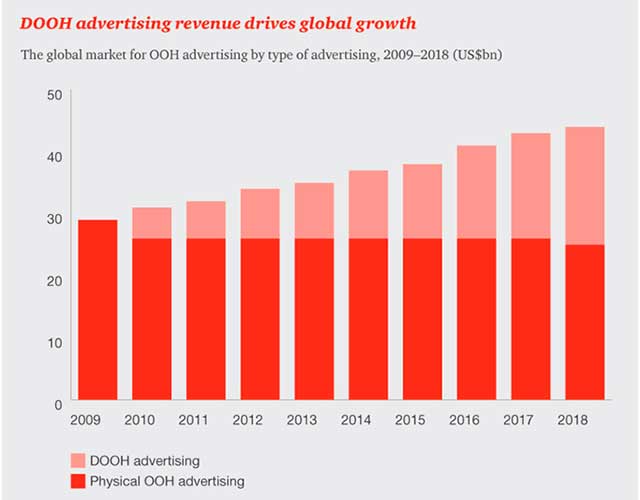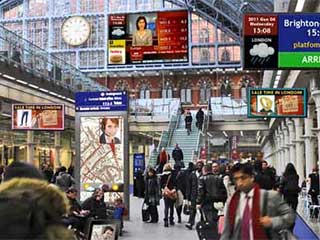Digital advertising market and forecasts
Can a forecast be accurate? People think differently. But modern men cannot survive without forecasts. Anyone working in the field of advertising, and specifically, digital advertising is eager to hear what are the chances of the industry development, of advertising revenues to grow, of production to rise. This is what we are concerned with, too.
The technology of digital advertising is constantly improving and supply approaches are advancing. New methods of displaying content to the audience appear regularly. However, the current limitations on even faster development are related to adequate and reliable reporting and the lack of return on investment analysis.
Statistical data for 2012-2014 shows the worldwide revenues for digital signage equipment, software, services and media at the level of 13.2, 13.9 and 14.3 billion US dollars, correspondingly. The conservative forecast for 2017 promises the number at slightly over 17 billion. This indicates an approximately 5% annual growth in spite of the relatively depressed economy of the developed countries. The numbers are rather optimistic. Naturally, the forecast made back in 2010 looked more attractive.

The forecast for the growth of digital advertising market from 2010 to 2018
The 2010 forecast obviously did not include the economic slowdown that happened in 2012. As you see, the accurate evaluation of market drivers is the key factor in determining the future of the industry. Digital advertising is not evenly spread around the world. North America (primarily, US and Canada) represents about half of world revenues.
 |
 |
| Giant informational and advertising LED screen at railway terminal | Digital out-of-home in action |
The analytical agency NPD DisplaySearch reports that screen deployment for digital installations (both LED and LCD panels) in North America exceeds 2 million units annually for the past three years. Naturally this significant growth is the result of the new advertising strategy: placement of relatively small displays (27 inch on the average) over the shop counters, in trading areas, in lift halls etc. In this total number the large LED screens, media façades and other spectacular and noticeable large electronic installations are relatively few: about 50 thousand installations.
Another research indicates that there are over 400 independently owned and operated advertising-based networks in the USA and Canada, more than 1000 corporate networks and 150 large manufacturing companies in the area of digital advertising. Sector employment in digital signage supply and operations is conservatively estimated at over 50 000 full time equivalent personnel.
For years this magazine has been writing about new digital media that is gradually takes shape, about outdoor TV, about merge between digital outdoor advertising and the Internet. This tendency has finally been recognized by the English-speaking professional community that offered new terms “The Outernet” among several other existing but limited in use and scope “Out-of-Home Video” and “Screenmedia”.
 |
 |
| Outdoor digital billboard by Ocean Outdoor | Digital billboard by APN Outdoor |
The key factors that determine the wide spread of digital advertising include:
- the significantly lower prices on digital signage and screens of all kinds;
- the increasing life and reliability of digital systems;
- the user-friendly software for content management systems (CMS);
- the use of different interactive functions;
- the ability to present messages at ideal times and to targeted audiences at points of purchase, waiting, travel, etc.
In spite of the complex economic situation in the world, digital networks are not shrinking in size or close down. This sends a clear message to future investors and guarantees future for the whole industry.
The growing market of processors, tremendous increase in their performance and speed, new functional capabilities turn the simple advertising screen from a player into a powerful computer that can be easily integrated into modern digital and communicative urban environment.
Moreover the market demand created a huge army of specialists-designers and artists who create really beautiful video commercials. Advertisers know well that content brings about sales. And digital displays allow the content to be tuned and fine-tuned at practically no cost and in no time, unlike traditional static outdoor advertising and printed media.
“Analytics” is the major negative factor in the digital signage industry development. All media investment is based on ROI (return on investment). All funding decisions are made with the aim of earning profits. So as digital signage is compared with other possible communications investments, impact measures such as recall, action intent and measurable outcomes become more important, and if not captured, an impediment to future funding.
History buffs may recall the phrase by John Wanamaker (1838 - 1922), who in 1876 opened a huge department store in the building of the old Philadelphia railway terminal: “Half the money I spend on advertising is wasted, the trouble is I don't know which half.”
Today we can calculate or evaluate nearly everything but the Wanamaker dilemma remains unresolved. As soon as the digital advertising proves its obvious advantages over other advertising carriers on the basis of low cost, fast ROI, long life and easy maintenance – the new era of digital growth will come.





